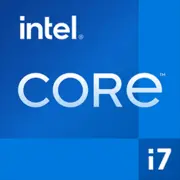Intel Core i7-13700HX

Intel Core i7-13700HX: Raptor Lake Power for Laptops – A Comprehensive Review
(Relevant as of March 2025)
Intel's 13th generation processors have established themselves in the market as reliable solutions for demanding tasks. Among them stands out the Intel Core i7-13700HX — a hybrid chip that combines high performance and flexibility. Let's explore who this CPU is suitable for, how it performs in gaming, work, and everyday tasks, and what to consider when choosing a laptop with it.
Architecture and Technology Process: The Hybrid Power of Raptor Lake
The processor is built on the Raptor Lake architecture and is manufactured using the Intel 7 (optimized 10 nm) technology process. This is Intel's second generation of hybrid chips that combines two types of cores:
- 8 Performance-cores (P-cores) with Hyper-Threading support: operate at high frequencies (base — 2.1 GHz, turbo — up to 5.0 GHz) for heavy tasks.
- 8 Efficient-cores (E-cores): optimized for energy efficiency (base frequency — 1.5 GHz, turbo — up to 3.7 GHz), handling background processes.
In total: 16 cores (8P + 8E) and 24 threads. This approach allows for load distribution: P-cores handle gaming, rendering, and complex calculations, while E-cores manage the browser, streaming, or updates.
Cache and Graphics:
- 30 MB L3 cache — the increased size speeds up data processing in multi-threaded scenarios.
- Integrated Intel UHD Graphics for the 13th Generation: 32 Execution Units (EUs), 4K@60Hz support, AV1 decoding. Not suitable for gaming but adequate for office tasks and video playback.
Power Consumption and TDP: Balancing Power and Heat
The nominal TDP of the processor is 55W, but in turbo mode, power can reach 157W. This imposes limitations:
- Laptops with the i7-13700HX require advanced cooling systems (e.g., 3-4 heat pipes and two fans).
- In compact cases (ultrabooks), the chip may throttle (reduce frequencies) due to overheating.
Tip: Choose devices with a specified power supply (Adapter) of at least 230W. Successful models include the Lenovo Legion Pro 7i or MSI Raider GE78HX.
Performance: From Office Work to 4K Rendering
Office and Multimedia
- Geekbench 6: 2501 (Single-Core), 13374 (Multi-Core) — results are higher than those of the Ryzen 9 6900HX (~15%) and the previous i7-12700H (~20%).
- Real Tasks:
- Running 50 tabs in Chrome + Photoshop + Zoom — no lags.
- 4K video conversion to H.265 (HandBrake): ~8-10 minutes compared to 12-14 minutes for the i7-12700H.
Gaming
The processor does not limit FPS when paired with a discrete graphics card (e.g., RTX 4070 or Radeon RX 7700S):
- Cyberpunk 2077 (Ultra, DLSS Quality): 85-90 FPS at 1440p.
- Hogwarts Legacy (Ultra): 70-75 FPS.
Turbo Mode: Under load, P-cores boost to 5.0 GHz, but only for 20-30 seconds. For prolonged sessions (streaming, rendering), the frequency stabilizes around ~4.2-4.5 GHz.
Usage Scenarios: Who Needs the i7-13700HX?
1. Gamers: For QHD/UHD gaming with high FPS.
2. Professionals: Video editors, 3D designers, CAD engineers.
3. Streamers: Simultaneous gaming and video encoding via OBS.
4. Enthusiasts: Those who rarely upgrade their laptop (the processor will remain relevant for another 3-4 years).
Cautions: Not suitable for users who prioritize battery life (over 6 hours) or compactness (laptops under 2 kg).
Battery Life: The Cost of Power
With a TDP of 55W, average battery life is:
- 4-5 hours under mixed load (web surfing, Office).
- 1.5-2 hours during gaming or rendering.
Power-Saving Technologies:
- Intel Dynamic Tuning 3.0: Automatically adjusts power between cores.
- Adaptix™ Technology: Optimizes load in "Power Saving" mode.
Tip: To extend battery life, enable "Power Saving" mode in Windows settings and limit the processor frequency to 80%.
Comparison with Competitors
AMD Ryzen 9 7940HS (Zen 4, 8 cores/16 threads):
- Better in single-threaded tasks (Geekbench 6 Single-Core: ~2600), but weaker in multi-threaded (~12500).
- Lower power consumption (TDP 45W), longer battery life.
Apple M2 Pro (12 cores):
- Leader in energy efficiency (10+ hours of battery life), but incompatible with Windows applications and games.
Intel Core i9-13900HX
- 10-15% more powerful in multi-threaded tests, but more expensive ($200-300) and hotter.
Conclusion: The i7-13700HX offers optimal price/performance for Windows laptops.
Pros and Cons
Strengths:
- Record multi-threaded performance.
- Support for DDR5-5600 and PCIe 5.0 (fast SSDs and graphics cards).
- Compatibility with Windows 10/11 and all modern games.
Weaknesses:
- High heat under load.
- Short battery life.
- Requires premium laptops (starting at $1500).
Recommendations for Laptop Selection
1. Device Type:
- Gaming Laptops (ASUS ROG Strix, Acer Predator): Discrete graphics at the level of RTX 4060 and above is essential.
- Mobile Workstations (Dell Precision, HP ZBook): Focus on cooling and ECC memory support.
- Versatile Models (MSI Creator): 4K screen and 100% sRGB color accuracy.
2. What to Look For:
- Cooling System: At least 3 fans and a "Turbo" mode in software.
- Screen: For gaming — 144+ Hz; for work — 4K IPS.
- Memory and SSD: 32 GB DDR5 + 1 TB PCIe 4.0 NVMe.
Examples of Laptops (2025):
- ASUS ROG Strix G16 ($1700): RTX 4070, 16 GB DDR5, 1 TB SSD.
- Lenovo ThinkPad P16 ($2200): 4K screen, ISV certification.
Final Conclusion
The Intel Core i7-13700HX is a processor for those who are not willing to sacrifice power for mobility. It is ideal for:
- Gamers looking to play at 2K/4K without lag.
- Professionals working with "heavy" applications.
- Users who value multitasking (streaming + gaming + browsing).
Alternatives:
- If battery life is essential — AMD Ryzen 9 7940HS.
- If on a budget — the previous generation (i7-12700H).
Prices for laptops with the i7-13700HX start at $1500, but their performance is justified for the target audience. Choose this processor if you're willing to carry a charger but don't want to compromise on speed.
Basic
CPU Specifications
Memory Specifications
GPU Specifications
Benchmarks
Compared to Other CPU
Share in social media
Or Link To Us
<a href="https://cputronic.com/cpu/intel-core-i7-13700hx" target="_blank">Intel Core i7-13700HX</a>